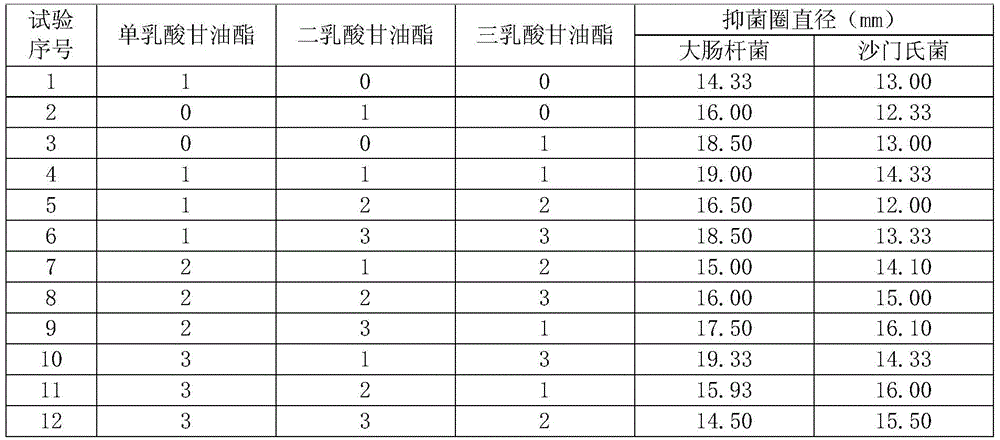An antibacterial feed additive and its application
A feed additive and feed technology, which is applied in the field of animal husbandry or feed, can solve the problems such as application reports of antibacterial feed additives with no antibacterial effect of glycerol lactate, and achieve the effects of improving feed conversion efficiency, avoiding acid corrosion damage, and promoting animal growth.
- Summary
- Abstract
- Description
- Claims
- Application Information
AI Technical Summary
Problems solved by technology
Method used
Image
Examples
Embodiment 1
[0018] According to the orthogonal test design table L9 (3 4 ) Arrange the combination (see test numbers 4 to 12 in Table 1), and use the Oxford cup method to determine the antibacterial activity of single substances of mono-, di- and tri-glycerides and their combinations.
[0019] Table 1 Antibacterial effect of glycerol lactate in vitro
[0020]
[0021] Note: The numbers in the table indicate the mass ratio of mono-glycerides, di-glycerides and tri-glycerides in combination.
[0022] The data in Table 1 shows that monolactate, dilactyl, and trilactate and their mixtures in different proportions have inhibitory effects on E. coli and Salmonella, and the size of the in vitro inhibition zone is 14.33-19.33mm and 12.00, respectively. ~ 16.10mm.
Embodiment 2
[0024] The glycerol monolactate, glycerol dilactide, and glycerol trilactate are 1:0:0, 0:1:0, 0:0:1, 1:0:2, 0:1:3 and 3 in mass ratios. :1:3 is fully mixed with liquid mixing equipment to prepare glycerol lactate mixture I, II, III, IV, V, VI. Then, the glycerol lactate mixture and defatted rice bran are thoroughly mixed according to a weight ratio of 1:1 to form the antibacterial feed additive of the present invention. The additive is added at 1.0% of the weight of the feed (the actual feed contains 0.5% of glycerol lactate).
[0025] The formula of this example is suitable for weaning piglets, and the application effect is obvious.
[0026] Feed the weaned piglets with this additive. A total of 168 21-day-old weaned piglets with the same weight and sex were randomly divided into 7 groups, each group had 3 replicates (columns), and each group had 8 piglets. The basal diets fed by the experimental groups were the same. Experiments Ⅰ, Ⅱ, Ⅲ, Ⅳ, Ⅴ and Ⅵ were fed with 1.0% antibac...
Embodiment 3
[0032] The glycerol monolactate, glycerol dilactide, and glycerol trilactate are 1:0:0, 0:1:0, 0:0:1, 2:1:0, 1:2:3 and 3 according to the mass ratio. :2:1 Fully mixed with liquid mixing equipment to prepare glycerol lactate mixture I, II, III, IV, V, VI. Then, the glycerol lactate mixture and the silicon dioxide are fully mixed according to the weight ratio of 1:1 to form the antibacterial feed additive of the present invention. The additive is added at 0.02% of the weight of the feed (the actual feed contains 0.01% of glycerol lactate).
[0033] The formula of this example is suitable for broilers, and the application effect is obvious.
[0034] Feed the Cobb broilers with this additive. 560 1-day-old Cobb broilers (half male and half male) with the same body weight were randomly divided into 7 groups with 8 replicates (cages) in each group, 10 per cage. The basal rations for all groups were the same. Experiments I, II, III IV, V, VI groups were fed with 0.02% antibacterial fe...
PUM
 Login to View More
Login to View More Abstract
Description
Claims
Application Information
 Login to View More
Login to View More - R&D
- Intellectual Property
- Life Sciences
- Materials
- Tech Scout
- Unparalleled Data Quality
- Higher Quality Content
- 60% Fewer Hallucinations
Browse by: Latest US Patents, China's latest patents, Technical Efficacy Thesaurus, Application Domain, Technology Topic, Popular Technical Reports.
© 2025 PatSnap. All rights reserved.Legal|Privacy policy|Modern Slavery Act Transparency Statement|Sitemap|About US| Contact US: help@patsnap.com



